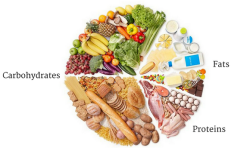Part 2: The Three Macronutrients
All of the calories in our food come from the three macronutrients that the majority of people are most familiar with: carbohydrates, protein and fat. These are referred to as macronutrients because they are normally contained in foods in the greatest abundance. Different fads in the diet world have led to many varied and often untrue beliefs about the importance of these three items in the diet. More importantly, many of the rationales cited for why limiting on macronutrient or another is beneficial have little or no reasonable application to endurance athletes. The goal of this article is to clear up some of these misconceptions.
Carbohydrates are the single most important nutrient you ingest. This is because they are the primary fuel for all types of exercise, whether it is long steady workouts at an easy pace or high-intensity interval workouts. It is true that you burn more fat the easier the workload, but you are still burning a high percentage of carbohydrates for energy even at low intensities. Carbs are also the sole energy source for the brain; the slumps that you may feel late in the day are often the result of insufficient sugar for the brain rather than a true loss in energy. For these reasons, long-term limitation of dietary carbohydrate is not recommended even for weight-loss purposes, as the side effects include low energy levels, poor concentration and reduced performance. As most athletes know, carbohydrate is readily available in fruits, vegetables, grains, pasta and anything containing sugar.
The other major source of fuel for endurance athletes is fat. Compared with carbohydrates and proteins, fat is a very dense source of energy, with one gram containing more than twice as many calories as the other two nutrients. The lower the intensity of exercise, the more important fat metabolism is.
This is because although it contains a lot of energy, fats take a long time to break down and during very intense efforts the breakdown process is not fast enough to supply the energy your body needs, so it gets that energy from carbs. During easier exercise, the turnover rate is slow enough that fats can be broken down quickly enough to meet the demand for energy. Fats are usually not a limiting factor during exercise because even the leanest athlete’s bodies contain 25,000 to 30,000 calories of stored fat. However, fat in our diet is important because it helps to slows down digestion, allowing our meals to stick with us longer, as well as providing a sense of satiety that helps limit overeating. Although we need fat in our diet, you should aim to ingest more of some fats, like the mono and poly-unsaturated fats that can help lower cholesterol, and avoid saturated and trans fats that increase cholesterol and risk for cardiovascular disease. Good sources of fats include fish, nuts, seeds and oils, such as olive and canola oil.
Many believe that insufficient protein in the diet will result in low energy levels, which is not the case. Although very important for athletes, under most circumstances, we will not obtain a significant amount of energy from protein. Only under extreme conditions of energy deprivation will protein be broken down for energy, and if you get to this point, it is likely that performance has already suffered severely in the absence of suitable carbohydrate for energy. The primary function of protein is in the building and repair of damaged muscles following a training session. Including appropriate amounts of protein, along with carbohydrates, following workouts ensures that nutrients are available to begin the recovery process immediately. Dietary protein is available from many sources, but is most prevalent in animal products: meat, fish, eggs and dairy. Non-meat sources include nuts, beans and small amounts that can be found in fruits and vegetables. However, it should be noted that the proteins found in plants are often not complete, meaning they do not contain all of the essential amino acids as meat sources do. For this reason, it may be necessary to mix and match vegetables to ensure you are getting all of the essential amino acids.
Hopefully, this has helped to clarify some of the myths about nutrition and the next time one of your training partners tells you they’re on this diet or that diet, you’ll be able to smile and tell them the real truth!

